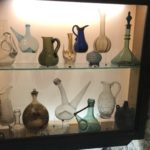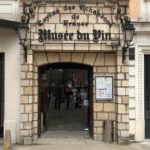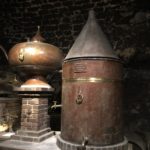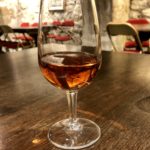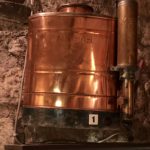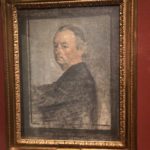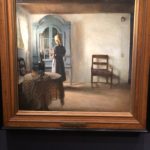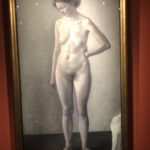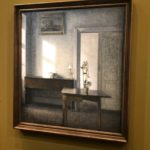http://punchdrunksoul.com/?wc-ajax=get_refreshed_fragments We depart after breakfast and headed over to metro stop Passy to visit the wine museum (Musee du Vin). Â While a stones trow from the apartment we have not been before, my brother and his wife visited on a previous trip and did not give it high marks

http://preferredmode.com/2014/06/17/daniel-2/ Musee du Vin
The Wine Museum is housed in what used to be crude limestone quarries that were mined between the 13th and the 18th centuries to supply the stones used to build Paris. This limestone is a characteristic feature of a geological age universally known as ‘Lutécien’ (from Lutece, the former name given to Paris) and is situated at 37.80 metres above sea-level. The museum galleries were dug out in the lower part of this geological layer by means of a “turning pillar†technique. The pillars were evenly spaced to support the quarry roof. Especially in the 19th century, stone walls were built as reinforcement for these galleries. The limestone was formed by the accumulation of seashells at the bottom of the warm sea that covered the area 45 million years ago. Fossils from these animals can still be seen in some places (bivalve mollusks or stretched shells). The well at the entrance of the museum is evidence of the existence of occasionally emerging groundwater. Several mineral water springs were actually discovered in the Passy area between the middle of the 17th century and 1754 (hence the name “Waters Roadâ€, “la rue des Eauxâ€). Deemed ferruginous and laxative, Passy spring water was exploited commercially until the Second Empire, though it was mainly in the 18th century that it became fashionable, attracting water takers from the Parisian ‘upper classes’, writers and artists.
The Wine Cellars of the Minims Monastery
 The three vaulted cellars, which today house the Museum restaurant, were used in the 16th and 17th centuries by the Friars of Passy Monastery for storing their wine. The information panels in the corridor leading to the museum recall the history of this monastery, which was built by the mendicant Friars of the Minims Order. This order was founded in 1472 by François Martorille (1436-1507) who was canonized as Saint Francis of Paola. This Calabrian hermit, known to be a thaumaturge (miracle worker), was summoned to Plessis-les-Tours on the Loire by King Louis XI in 1475 and was allowed to expand his order in France. Construction of the monastery began in 1493 and was encouraged and enriched by Queen Anne of Brittany. Built along today’s Beethoven Road, the monastery was surrounded by gardens and terraces going down to the Seine with orchards and vines planted on the hillside. From these vines, the Friars used to produce a light red wine which King Louis XIII liked to drink on his return from hunting in the Bois de Boulogne. Today, this history is evoked in the presence of surrounding street names such as ‘rue Vineuse’ (Winy Road) and the ‘rue des Vignes’ (Vineyard Road). The monastery was abandoned during the Revolution and the buildings destroyed.
The three vaulted cellars, which today house the Museum restaurant, were used in the 16th and 17th centuries by the Friars of Passy Monastery for storing their wine. The information panels in the corridor leading to the museum recall the history of this monastery, which was built by the mendicant Friars of the Minims Order. This order was founded in 1472 by François Martorille (1436-1507) who was canonized as Saint Francis of Paola. This Calabrian hermit, known to be a thaumaturge (miracle worker), was summoned to Plessis-les-Tours on the Loire by King Louis XI in 1475 and was allowed to expand his order in France. Construction of the monastery began in 1493 and was encouraged and enriched by Queen Anne of Brittany. Built along today’s Beethoven Road, the monastery was surrounded by gardens and terraces going down to the Seine with orchards and vines planted on the hillside. From these vines, the Friars used to produce a light red wine which King Louis XIII liked to drink on his return from hunting in the Bois de Boulogne. Today, this history is evoked in the presence of surrounding street names such as ‘rue Vineuse’ (Winy Road) and the ‘rue des Vignes’ (Vineyard Road). The monastery was abandoned during the Revolution and the buildings destroyed.
The Echansons Council of France (Le Conseil des Echansons de France)
 Renovated in the 1950s, the ancient wine cellars were for a time used as a wine storage room for the restaurant at the Eiffel Tower. It later became the Wine Museum and since 1984 has been under the ownership of the «Conseil des Echansons de France». This council, founded in 1954, is dedicated to the defense and promotion of the finest French wines. To this end, the Council organizes many prestigious events throughout France, abroad and here at the museum. The council unites several thousand professionals and wine-lovers from all over the world who promote the “savoir-faire†and quality for which French wines are renowned.
Renovated in the 1950s, the ancient wine cellars were for a time used as a wine storage room for the restaurant at the Eiffel Tower. It later became the Wine Museum and since 1984 has been under the ownership of the «Conseil des Echansons de France». This council, founded in 1954, is dedicated to the defense and promotion of the finest French wines. To this end, the Council organizes many prestigious events throughout France, abroad and here at the museum. The council unites several thousand professionals and wine-lovers from all over the world who promote the “savoir-faire†and quality for which French wines are renowned.
While we enjoyed a glass of wine after the tour in the tasting cell the curator of the museum, Jean-Jacques Hervy, stop by our table and we chatted about the wines from the Gaillac region in French and English.  We opted to try 2 wines a dry Rosé  (2009)and a red (2010), the rosé had a deeper pink/red due to aging and leaned in the direction of a very light red wine made from the Duras grape while still considered a rosé.  The red was a blend of the grape from Gaillac, a Syrah and a Gamay.
Our next stop was the Musée Jacquemart-André on Boulevard Haussmann to see and exhibition by a master of Danish painting named Vilhelm Hammershøi (1864-1916).
Initially exhibited in Paris at the Petit Palais in 1987 and subsequently in the Musée d’Orsay in 1997, visitors were fascinated by Hammershøi’s paintings representing empty and subtly rendered interiors that sometimes feature a woman whose back faces the viewer, painted in grey and white tones.
The exhibited paintings will represent Hammershøi’s entire oeuvre and its mysterious and profound atmosphere. A withdrawn and quiet individual, Hammershøi spent all of his life in a small circle of family and friends, all of whom constantly featured in his paintings: his mother, sister, brother, and brother-in-law all posed for him, as did several close friends. He also painted his wife, Ida, who is often seen from the back in many of the works that have made him famous.
You will also discover Hammershøi’s links with France, his two stays in Paris, and his participation in the Exposition Universelle in Paris (1889 and 1900).
The Musée Jacquemart-André will display Hammershøi’s art from a fresh perspective by illustrating his links with the artists in his circle. For the first time, this retrospective will compare Hammershøi’s works with paintings executed by his brother Svend Hammershøi, his brother-in-law Peter Ilsted, and his friend Carl Holsøe. This comparative approach will highlight their affinities, differences, and the unique genius of Vilhelm Hammershøi, the artist of solitude, silence, and light.
Forty works will reveal the mysterious and poetic world of the artist. Previously unseen works from the Ambassador John L. Loeb Jr. Danish Art Collection, which are rarely exhibited during the major international retrospectives devoted to Hammershøi’s oeuvre, will be displayed for the first time in France
The exhibition will also include loaned works from major Danish and Swedish museums, such as the Statens Museum for Kunst and the Hirschprungske Samling in Copenhagen, the Nationalmuseum and the Thielska Galleriet in Stockholm, and the Malmö Konstmuseum, as well as the Musée d’Orsay and London’s Tate Gallery, and from private collections. Major works will illustrate every aspect of Hammershøi’s oeuvre: his first portraits, nudes, architectural views, landscapes, and the extraordinary interior scenes that have made him so famous.
We’re now back in the apartment (3:45) planning our afternoon shopping for dinner and breakfast sojourn. Stops will include vegetable/fruit vendor, fresh pasta store and of course the bakery for todays bread.
Steps today = 7,850 or 3.5 miles






